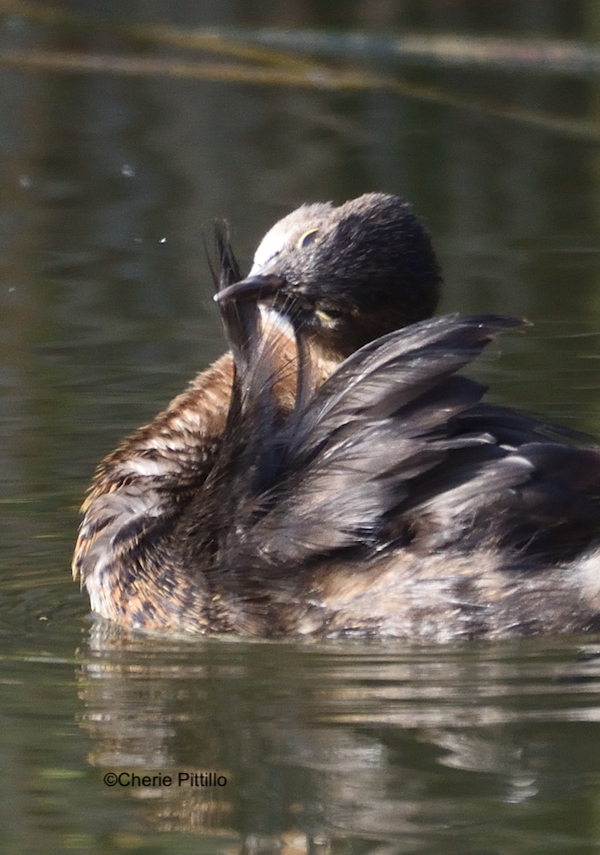
In this month of humid-to-us heat, I thought I’d share refreshing photos of birds bathing. It’s no big deal to just wash those feathers and keep them in good condition, right? Nope. Just as humans have a variety of ways to shower, such as washing arms first or washing a face first, bird families have distinct methods of taking a bath. And if you thought all birds tailor their baths to get completely soaked at one time and then to swiftly shake it off, shake it off, well, you need to read on…
In most land birds, contour feathers give shape to the body, wings, and tail; they cover only about 30% of the body. Those feathers grow in rows or tracts which are called pterylae. (That p is silent so it sounds like a southern name of Terry Lee.) Bare skin mainly exists between those tracts. Those spaces are called aptera.
Think about a chicken with its feathers. You don’t see the skin because of fluffed feathers. However, if you buy chicken at the grocery store, you can see pores in rows or what appears like tiny bumps on the skin. Those pore or follicles are where the feathers grow just like your pores or follicles produce hair.

When birds bathe in water, they open and close certain feather rows to wet the in-between spaces along with adjacent feather bases. In addition they may also fluff the feathers, flick wings vigorously, duck their head and body parts under water as a few examples of techniques. Wash and rinse cycles can be repeated many times with necessary preening during and after the bath.
According to some scientists, exceptions occur where an even distribution of feathers covers penguins, ostrich-like birds, and screamers of South America (I’m referring to a bird, pictured below.) However, other scientists report that all birds organize their feathers into tracts and “some bare skin.” And they highly recommend different feather arrangements can be consistently useful in classification.

Another trait about bathing birds depends on their leg and feet strength. Most songbirds can either sit or stand in shallow water due to their strong legs and feet. They open and close certain rows of feathers, shake their wings to create a shower, and may fly to a perch to vibrate their wings and then return to bathe and perch several times.

On the other hand, uh, or foot, swallows, swifts, and terns with short weak legs and feet, dive or dunk into water to scoop it over their backs several times.
Forest birds may use rainwater or dew on leaves. Most woodpeckers with their short weak legs expose their feathers to rain, dew, or fog. However, I have observed the Golden-fronted Woodpecker at Dzibilchaltun sitting and bathing in shallow water. On a foggy morning this Laughing Falcon slightly opened its damp wings to dry at Playa del Carmen.


Waterfowl including grebes, ducks, swans, and geese can either bathe during a dive or at the surface. They open their feather rows, preen, flap their wings, repeat, repeat, repeat. Here is a Black-bellied Whistling Duck that bathed first, then stood to flap the wings back and forth to shake off excess water.
While preening can occur during the wash cycle, all birds typically preen after bathing too. It’s more than just working fresh oil from the preen gland at the tail base on to plumage. The bird pulls feathers through its beak to remove dirt, oil, and parasites. Scientists thought the oil waterproofed the feathers, but now research indicates the bird’s bill zips the feathers back into place which locks the parts of the feather together to be water-tight. Check out this Pied-billed Grebe’s feather where below the beak, the feather looks smooth and above the feather is not in place. Zip, zip, zip.

During preening, waterfowl and many avian species also smear oil from the preen gland on their necks and heads, like in the grebe photos. They can then spread the oil on other body parts with their heads and necks or only their bills to keep the feathers supple.



During bathing, the bird’s vision, hearing, and water-soaked wings are impaired in case the bird needed to escape.

When a bird senses danger or bathes in the open, it may use various techniques such as quick, shallow bathing, or not dunking the head so it can see and listen, or take a short bath or fly to a perch, flutter the wings to get rid of water, and then take another short bath. It may delay the time before it performs any washing maneuvers.
If you think that birds only bathe with water,(fog, dew, drizzle, and snow), what about sun baths and dust baths? They also offer cleansing baths. Stay tuned for Part 2 for more details.
IMMERSE IN NATURE TO CLEAN YOUR SOUL
DISCLAIMER: REFERENCES DO NOT AGREE ON INFORMATION:
The Handbook of Bird Biology, Sal a Pajarear Yucatán, Bird & Reserves of the Yucatan Peninsula, A Guide to the Birds of Mexico and North Central America, The Sibley Guide to Birds, Lives of North American Birds, Fowler’s Zoo and Wild Animal Medicine, Volume 8, Revista Brasileira de Ornitologia,
https://sora.unm.edu/sites/default/files/journals/auk/v087n01/p0091-p0099.pdf
https://www.academia.edu/3201250/Processes_in_feathers_caused_by_bathing_in_water
https://web.stanford.edu/group/stanfordbirds/text/essays/Bathing_and_Dusting.html
https://www.startribune.com/nature-notes-bird-bathing-has-a-purpose-more-than-cleaning/387839031/
https://faculty.weber.edu/jcavitt/Feather1.pdf
https://www.britannica.com/science/integument/Reptiles#ref315423
https://academic.oup.com/condor/article-abstract/42/2/112/5251053
https://www.sciencedaily.com/releases/2019/03/190328150700.htm
Elder, William H. Oil Gland of Birds. The Wilson Bulletin, 66, (1), 6-31, March, 1954
http://www.birdsofseabrookisland.org/taxa/t000d-evidence4.html
https://web.stanford.edu/group/stanfordbirds/text/essays/Spread-Wing_Postures.html
https://jeb.biologists.org/content/jexbio/204/23/4081
https://birdsoftheworld.org/bow/species/anhing/cur/behavior#locom
https://birdsoftheworld.org/bow/species/doccor/cur/behavior#locom
https://www.nps.gov/ever/learn/nature/anhinga.htm
Cherie Pittillo, “nature inspired,” photographer and author, explores nature everywhere she goes. She’s identified 56 bird species in her Merida, Yucatan backyard view. Her monthly column features anecdotes about birding in Merida, Yucatan and also wildlife beyond the Yucatan.
Contact: [email protected] All rights reserved, ©Cherie Pittillo










